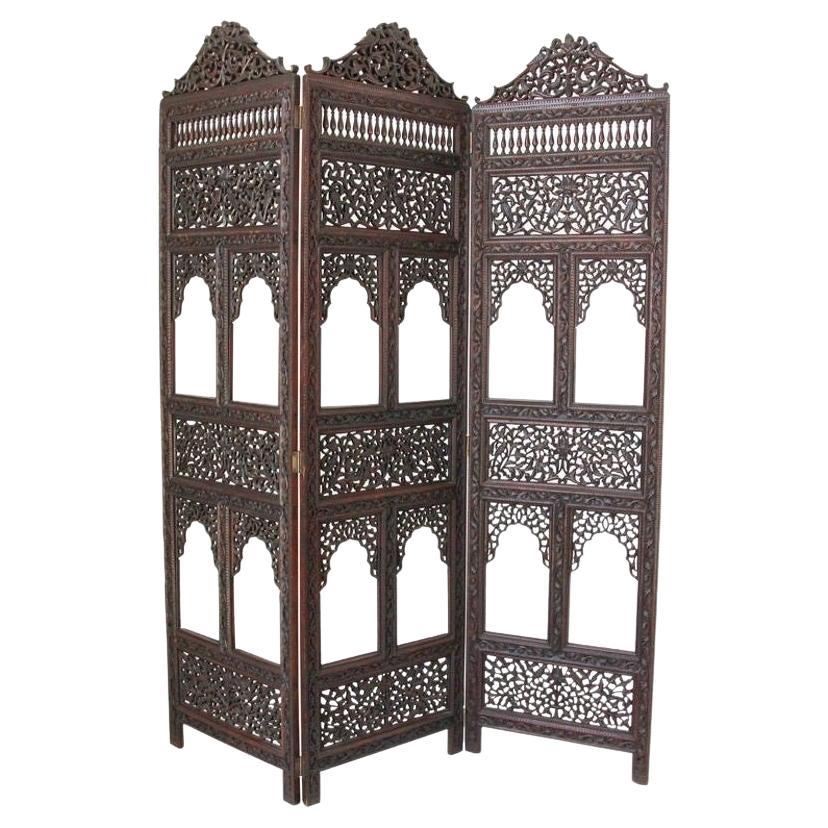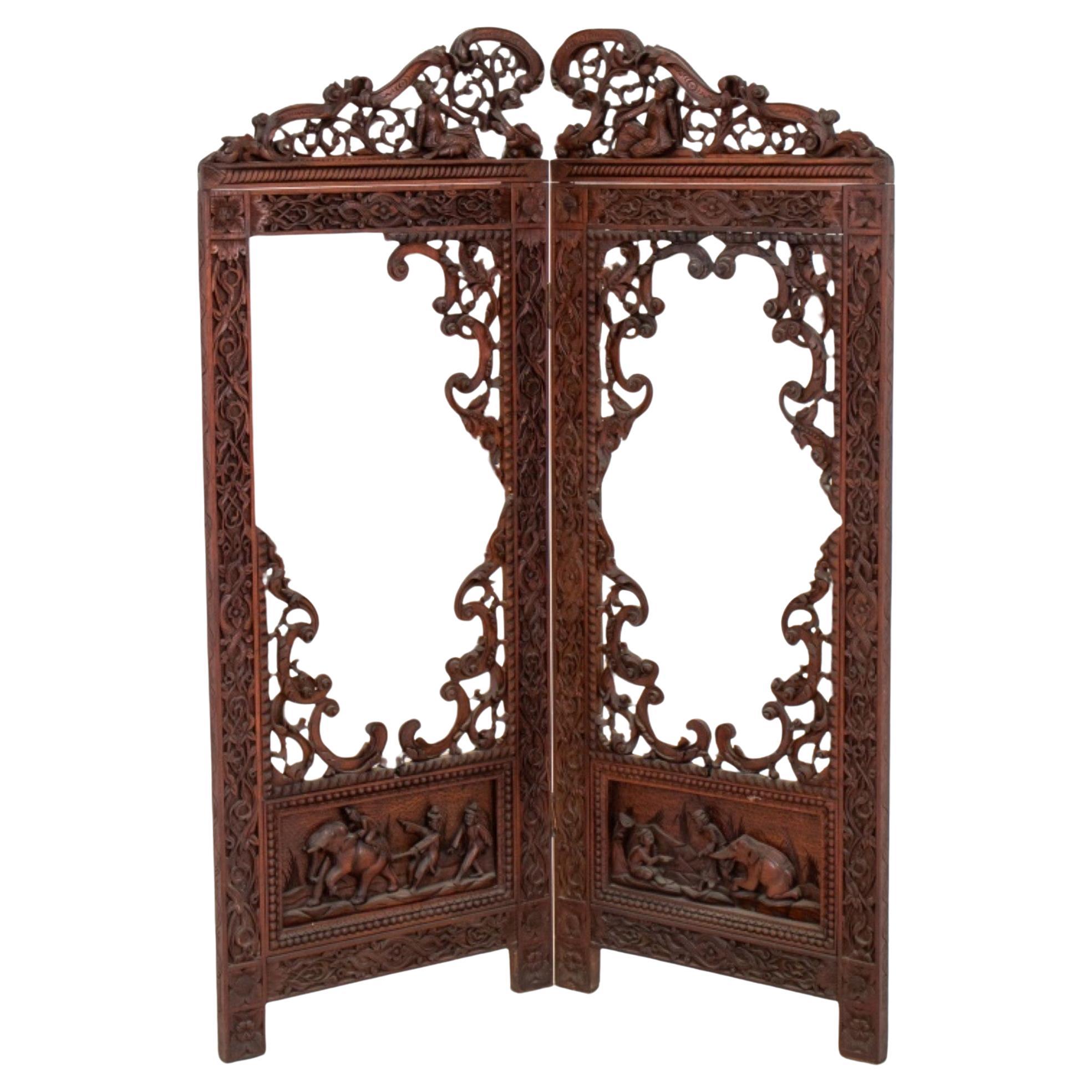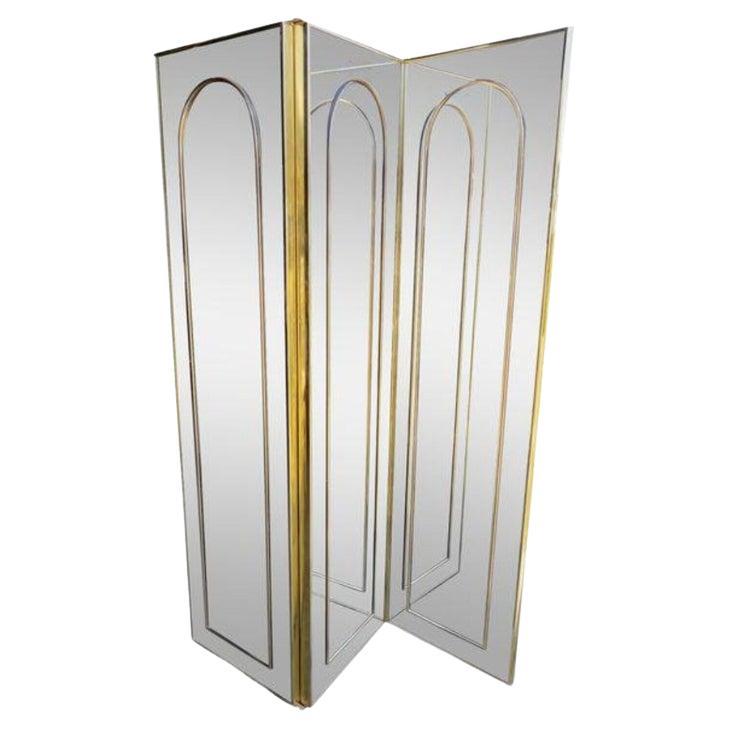Items Similar to 20C Anglo Indian Style Double Sided Profusely Inlaid 4 Panel Screen
Want more images or videos?
Request additional images or videos from the seller
1 of 21
20C Anglo Indian Style Double Sided Profusely Inlaid 4 Panel Screen
About the Item
PRESENTING AN EXCEPTIONAL 20C Anglo Indian Style Double Sided Profusely Inlaid 4 Panel Screen or Room Divider.
Made in Hoshiarpur, India, circa 1960-80.
Made of ‘teak’ wood in the Mughal Style, with pierced frieze panels and profusely inlaid with white plastic (faux ivory), to replicate earlier, ivory inlaid Hoshiarpur craftsmanship.
NOTE: We have tested the inlay and there is no elephant ivory in this piece and therefore it is 100% legal under CITES restrictions. The use of plastic/resin, rather than elephant ivory, tells us that this is a 20th Century piece.
It is a 4 panel, hinged, foldable screen and double sided.
Each panel is of identical construction, design and decoration … front and back.
The crown/top section has an arched and curved, Mughal or Islamic arched style top, a central inlaid faux ivory peacock and pierced frieze surround.
Below this is another pierced frieze panel.
Then it has a solid and profusely inlaid rectangular panel which is edged with faux ivory and ebony chevrons, floral inlay inside that and then an oval inlaid central medallion featuring 3 Elephants, a Lion and 2 Deer.
The lower central section features a rectangular vertical solid panel which is edged with faux ivory and ebony chevrons, then an inlaid central section featuring a ‘fabulous’ Peacock, perched up on a leafy tree branch, with flowing plumes extending downwards.
The base central panel again features a central inlaid faux ivory peacock and pierced frieze surround, to replicate the one on top.
All the side and cross supports (holding the panels in place) are inlaid with faux ivory floral decorations and each side pillar ends with an inlaid ‘urn’.
The inlaid animals ALL have been hand-painted using traditional Indian ‘lac’ ink.
THIS IS A CLASSIC example of the type of furniture that was being made by expert craftsmen in Hoshiarpur, from the early 1700’s .. up to this very day.
Up to Indian independence in the 1950’s, almost all of this furniture, was made for export and specifically for sale to British Military Officers, Diplomats and visiting “Nobility/Gentry’.
WHEN IT COMES TO HOSHIARPUR INLAID FURNITURE … THIS IS AS GOOD AS IT GETS!
Provenance: From a Quality Houston, TX Estate
Dimensions: Each Panel is 72 inches tall, 20 inches wide and 0.75 inches deep
Fully Opened the Screen is 72 inches tall, 80 inches wide and 0.75 inches deep
Fully Closed the Screen is 72 inches tall, 20 inches wide and 4 inches deep.
Condition: Very good original condition. No losses of inlay to any of the main panels. No missing, broken or cracked frieze panels. Some very slight fading and bowing/warping through age, but not significant.
- Dimensions:Height: 72 in (182.88 cm)Width: 20 in (50.8 cm)Depth: 4 in (10.16 cm)
- Style:Anglo-Indian (In the Style Of)
- Materials and Techniques:
- Place of Origin:
- Period:
- Date of Manufacture:1960-80
- Condition:Wear consistent with age and use. Minor losses. Minor structural damages. Minor fading. Very good original condition. Some very slight fading and bowing/warping through age, but not significant.
- Seller Location:Dallas, TX
- Reference Number:1stDibs: LU3978138753732
About the Seller
4.9
Platinum Seller
These expertly vetted sellers are 1stDibs' most experienced sellers and are rated highest by our customers.
Established in 2015
1stDibs seller since 2018
349 sales on 1stDibs
Typical response time: <1 hour
- ShippingRetrieving quote...Ships From: Dallas, TX
- Return PolicyA return for this item may be initiated within 7 days of delivery.
More From This SellerView All
- 19C Anglo Indian Vizigapatam Stamp BoxLocated in Dallas, TXPresenting an absolutely gorgeous and very rare 19C Anglo Indian Vizigapatam stamp box. Made in Colonial India (the Time of the Raj) circa 1860. Prob...Category
Antique Mid-19th Century Indian Anglo-Indian Decorative Boxes
MaterialsBone, Shell
- 19C Anglo Indian Silver Perfume Bottle CaseLocated in Dallas, TX19C Anglo Indian solid silver perfume bottle case. Lovely 19th century Anglo-Indian solid silver perfume bottle case with profuse repousse work. Not hallmarked because it was m...Category
Antique Late 19th Century Indian Anglo Raj Sterling Silver
MaterialsSterling Silver
- Early 20C Irish Georgian Style Mahogany Low Boy.Located in Dallas, TXPRESENTING A LOVELY Early 20C Irish Georgian Style Mahogany Low Boy. VERY NICE Irish Mahogany Low Boy, chest of 3 drawers, on stand. Additional drawer on stand, making 4 drawers in...Category
Early 20th Century Irish George III Commodes and Chests of Drawers
MaterialsBrass
- 19C Anglo Indian Sadeli Mosaic Greeting Card CaseLocated in Dallas, TXPresenting a superb 19C Anglo Indian Sadeli Mosaic greeting card case. Made in or around Bombay, India circa 1880. This is a greeting card case used for holding your greeting cards or business cards of the day ! The body of the case is made from sandalwood and it is fully overlaid with bone and highly intricate Sadeli Mosaic made up of thousands of micro mosaic pieces of bone, ebony, silver/pewter and semi precious stone. The workmanship is stupenduous !!!! This case is almost museum quality. One or two very, very minor losses of mosaic mainly where the top meets the body but otherwise near mint ! SADELI MOSAIC: “Anglo Indian boxes were made in India for the English residents from the early part of the 18th century. They were brought back or sent back to England usually by the people who had commissioned them. From the beginning of the nineteenth century they were imported more commercially, although not in any significant numbers until the middle decades. They were very highly valued, especially the early ones, to the extent that the designs were copied on late 19th and early 20th century tins. The ancient art of Sadeli Mosaic is said to have been introduced from Shiraz in Persia via Sind to Bombay, a long time before the Anglo Indian boxes were made. It was a technique, which required a high degree of skill and patience. It was executed very lavishly, in that the frequent cuts wasted a great amount of the precious materials used. The workmanship was however more than commensurable to the value of the materials. Ivory, silver, pewter (or other metals), wood and horn were cut into faceted rods which were bound together to form geometric patterns. When the glue has set, the rods were sliced in transverse sections. This gave the maker a number of angled circular pieces in the original pattern. Several variations of patterns could be achieved by combining the materials in different ways. The ivory was sometimes dyed green to give an extra color. The mosaic pieces in a combination of patterns, often separated by ivory, ebony, horn or silver stringing were used to veneer sandalwood boxes. In the early boxes, which date from the turn of the 18th to the 19th century, there are large panels of mosaic covering tops and sides of boxes. It took incredible skill to cover such large areas without any shakes or wavering of the pattern. The corners and joins on these boxes are impeccably matched. The makers (reputed to be Persian) of Sadeli mosaic made in the first two decades of the 19th century displayed a total understanding of the qualities of the different materials they used. They combined substances, which can expand and contract according to atmospheric conditions with others, which are hard and unyielding. The result was a sharp definition of the lines and patterns, which made up the whole design. On the early boxes the designs look deceptively simple. The fact is, they emerged from a culture, which had mastered geometry and understood how to generate a pattern from a set number of points. The patterns are so harmoniously combined that their incredible complexity is not immediately apparent. The earliest Sadeli boxes...Category
Antique Late 19th Century Indian Anglo Raj Decorative Boxes
MaterialsBone, Precious Stone, Ebony
- 19C Anglo Indian Bombay MOP Sadeli Mosaic Trinket BoxLocated in Dallas, TXPRESENTING a LOVELY 19C Anglo Indian Bombay MOP (Mother of Pearl) Sadeli Mosaic Trinket Box from circa 1875-85. Gorgeously detailed and hand-crafted ‘sadeli mosaic’ inlay, from the Bombay Area, with deep greens with silver, pewter, mother of pearl, bone and ebony in geometric patterns. The box case, is made of sandalwood but completely covered in MOP, bone, faux ivory, ebony and mosaic inlay. Edged with faux ivory and banded with a different pattern of sadeli mosaic. Some minor damage to the top (repair is obvious in pics) and ivorine replacements to some edging, but it still a BEAUTIFUL BOX and of real QUALITY! The mosaic work is FABULOUS! Box opens to reveal its original blue velvet lining. It sits on 4 (recently added) silvered button feet. SADELI MOSAIC: “Anglo Indian boxes were made in India for the English residents from the early part of the 18th century. They were brought back or sent back to England usually by the people who had commissioned them. From the beginning of the nineteenth century they were imported more commercially, although not in any significant numbers until the middle decades. They were very highly valued, especially the early ones, to the extent that the designs were copied on late 19th and early 20th century tins. The ancient art of Sadeli Mosaic is said to have been introduced from Shiraz in Persia via Sind to Bombay, a long time before the Anglo Indian boxes were made. It was a technique, which required a high degree of skill and patience. It was executed very lavishly, in that the frequent cuts wasted a great amount of the precious materials used. The workmanship was however more than commensurable to the value of the materials. Ivory, silver, pewter (or other metals), wood and horn were cut into faceted rods which were bound together to form geometric patterns. When the glue has set, the rods were sliced in transverse sections. This gave the maker a number of angled circular pieces in the original pattern. Several variations of patterns could be achieved by combining the materials in different ways. The ivory was sometimes dyed green to give an extra color. The mosaic pieces in a combination of patterns, often separated by ivory, ebony, horn or silver stringing were used to veneer sandalwood boxes. In the early boxes, which date from the turn of the 18th to the 19th century, there are large panels of mosaic covering tops and sides of boxes. It took incredible skill to cover such large areas without any shakes or wavering of the pattern. The corners and joins on these boxes are impeccably matched. The makers (reputed to be Persian) of Sadeli mosaic made in the first two decades of the 19th century displayed a total understanding of the qualities of the different materials they used. They combined substances, which can expand and contract according to atmospheric conditions with others, which are hard and unyielding. The result was a sharp definition of the lines and patterns, which made up the whole design. On the early boxes the designs look deceptively simple. The fact is, they emerged from a culture, which had mastered geometry and understood how to generate a pattern from a set number of points. The patterns are so harmoniously combined that their incredible complexity is not immediately apparent. The earliest Sadeli boxes...Category
Antique Late 19th Century Indian Anglo-Indian Jewelry Boxes
MaterialsSilver
- 20C Chinese Soapstone Polished BowlLocated in Dallas, TXPresenting a lovely 20C Chinese soapstone polished bowl. Made in China in the early 20th century circa 1930. This is a medium sized jade green an...Category
Early 20th Century Chinese Chinese Export Sculptures and Carvings
MaterialsSoapstone
You May Also Like
- Anglo-Indian Mughal Hardwood Three-Panel ScreenLocated in North Hollywood, CAAnglo-Indian hardwood three-panel Screen. This is a beautifully carved sculptural hardwood Anglo-Indian Wooden Mughal screen in Victorian colonial Raj. T...Category
Antique Late 19th Century Indian Anglo Raj Furniture
MaterialsHardwood
- Anglo Indian Wooden Lattice Three Panel ScreenLocated in New York, NYAnglo Indian wooden lattice three panel screen, each panel with scrolling crestrail and finials above a latticework upper register atop nine paneled segments with leaf-carved borders...Category
Early 20th Century Anglo-Indian Screens and Room Dividers
MaterialsWood
- 4 Panel Anglo Indian White Washed Folding ScreenLocated in Sheffield, MAWhite washed Anglo-Indian 4 panel folding screen or room divider. Elaborately carved wood screen from the early 20th century. This screen is covered with stunningly intricate hand carved details, a great example of the Indian carving...Category
20th Century Indian Anglo-Indian Screens and Room Dividers
MaterialsTeak
- Anglo-Indian Rosewood Two Panel ScreenLocated in New York, NYIndo-Portuguese rosewood two-panel screen, potentially originating from Goa, India. Here's a breakdown of its key features: Origin: Indo-Portuguese (combining Indian and Portuguese...Category
Antique 19th Century Indian Screens and Room Dividers
MaterialsWood
- Antique Anglo-Indian Hand-Painted Wooden Four Panel Screen or Room DividerLocated in Hamilton, OntarioThis four hinged panel screen or room divider has no maker's label or signature, but is presumed to have originated from India and date to approximately ...Category
Early 20th Century Indian Anglo-Indian Screens and Room Dividers
MaterialsSoftwood
- 3 Panel Double Sided Mirror Screen / Room DividerLocated in Dallas, TXMid century mirrored screen / room divider. The three panels are mirrored front and back, with the front side featuring brass arches. Panels meet at top and bottom hinges to stand in...Category
Vintage 1970s Hollywood Regency Screens and Room Dividers
MaterialsBrass





